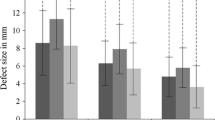Abstract
Purpose
In undetached osteochondral lesions (OCL) of the talus both revitalisation of the subchondral necrosis and cartilage preservation are essential. For these cases, we assess the results of minimally invasive retrograde core drilling and cancellous bone grafting.
Methods
Forty-one osteochondral lesions of the talus (12x grade I, 22x grade II and 7x grade III according to the Pritsch classification, defect sizes 7–14 mm) in 38 patients (mean age 33.2 years) treated by fluoroscopy-guided retrograde core drilling and autologous cancellous bone grafting were evaluated by clinical scores and MRI. The mean follow-up was 29.0 (±13) months.
Results
The AOFAS score increased significantly from 47.3 (±15.3) to 80.8 (±18.6) points. Lesions with intact cartilage (grades I and II) had a tendency to superior results than grade III lesions (83.1 ± 17.3 vs. 69.4 ± 22.2 points, p = 0.07). First-line treatments and open distal tibial growth plates led to significantly better outcomes (each p < 0.05). Age, gender, BMI, time to follow-up, defect localisation or a traumatic origin did not influence the score results. On a visual analogue scale pain intensity reduced from 7.5 (±1.5) to 3.7 (±2.6) while subjective function increased from 4.6 (±2.0) to 8.2 (±2.3) (each p < 0.001). In MRI follow-ups, five of the 41 patients showed a complete bone remodelling. In two cases demarcation was detectable.
Conclusions
The technique reported is a highly effective therapeutic option in OCL of the talus with intact cartilage grades I and II. However, second-line treatments and grade III lesions with cracked cartilage surface can not be generally recommended for this procedure.





Similar content being viewed by others
References
Zengerink M, Szerb I, Hangody L, Dopirak RM, Ferkel RD, van Dijk CN (2006) Current concepts: treatment of osteochondral ankle defects. Foot Ankle Clin 11:331–359
Takao M, Ochi M, Naito K, Uchio Y, Kono T, Oae K (2003) Arthroscopic drilling for chondral, subchondral, and combined chondral-subchondral lesions of the talar dome. Arthroscopy 19:524–530
Draper SD, Fallat LM (2000) Autogenous bone grafting for the treatment of talar dome lesions. J Foot Ankle Surg 39:15–23
Hangody L, Kish G, Modis L, Szerb I, Gaspar L, Dioszegi Z, Kendik Z (2001) Mosaicplasty for the treatment of osteochondritis dissecans of the talus: two to seven year results in 36 patients. Foot Ankle Int 22:552–558
Becher C, Thermann H (2005) Results of microfracture in the treatment of articular cartilage defects of the talus. Foot Ankle Int 26:583–589
Wagner H (1964) Surgical treatment of osteochondritis dissecans, a cause of arthritis deformans of the knee. Rev Chir Orthop Reparatrice Appar Mot 50:335–352
Conti SF, Taranow WS (1996) Transtalar retrograde drilling of medial osteochondral lesions of the talar dome. Operat Tech Orthop 6:226–230
Berndt AL, Harty M (1959) Transchondral fractures (osteochondritis dissecans) of the talus. J Bone Joint Surg Am 41-A:988–1020
Pritsch M, Horoshovski H, Farine I (1986) Arthroscopic treatment of osteochondral lesions of the talus. J Bone Joint Surg Am 68:862–865
Kitaoka HB, Alexander IJ, Adelaar RS, Nunley JA, Myerson MS, Sanders M (1994) Clinical rating systems for the ankle-hindfoot, midfoot, hallux, and lesser toes. Foot Ankle Int 15:349–353
Hunt SA, Sherman O (2003) Arthroscopic treatment of osteochondral lesions of the talus with correlation of outcome scoring systems. Arthroscopy 19:360–367
Canale ST, Belding RH (1980) Osteochondral lesions of the talus. J Bone Joint Surg Am 62:97–102
Letts M, Davidson D, Ahmer A (2003) Osteochondritis dissecans of the talus in children. J Pediatr Orthop 23:617–625
Bruns J, Rosenbach B (1992) Osteochondrosis dissecans of the talus. Comparison of results of surgical treatment in adolescents and adults. Arch Orthop Trauma Surg 112:23–27
Kono M, Takao M, Naito K, Uchio Y, Ochi M (2006) Retrograde drilling for osteochondral lesions of the talar dome. Am J Sports Med 34:1450–1456
Kendoff D, Geerling J, Mahlke L, Citak M, Kfuri M Jr, Hufner T, Krettek C (2003) Navigated Iso-C(3D)-based drilling of a osteochondral lesion of the talus. Unfallchirurg 106:963–967
Rosenberger RE, Fink C, Bale RJ, El Attal R, Muhlbacher R, Hoser C (2006) Computer-assisted minimally invasive treatment of osteochondrosis dissecans of the talus. Oper Orthop Traumatol 18:300–316
Lee CK, Mercurio C (1981) Operative treatment of osteochondritis dissecans in situ by retrograde drilling and cancellous bone graft: a preliminary report. Clin Orthop Relat Res 158:129–136
Taranow WS, Bisignani GA, Towers JD, Conti SF (1999) Retrograde drilling of osteochondral lesions of the medial talar dome. Foot Ankle Int 20:474–480
Takao M, Innami K, Komatsu F, Matsushita T (2010) Retrograde cancellous bone plug transplantation for the treatment of advanced osteochondral lesions with large subchondral lesions of the ankle. Am J Sports Med 38:1653–1660
Ettl V, Kenn W, Radke S, Kirschner S, Goerttler-Krauspe I, Vispo-Seara JL (2001) The role of MRI in therapy and follow-up after surgical treatment of osteochondrosis dissecans of the talus. Z Orthop Ihre Grenzgeb 139:157–162
Radke S, Vispo-Seara J, Walther M, Kenn W, Kirschner S, Ettl V, Eulert J (2004) Osteochondral lesions of the talus—indications for MRI with a contrast agent. Z Orthop Ihre Grenzgeb 142:618–624
Kumai T, Takakura Y, Higashiyama I, Tamai S (1999) Arthroscopic drilling for the treatment of osteochondral lesions of the talus. J Bone Joint Surg Am 81:1229–1235
Conflict of interest
The authors declare that they have no conflict of interest.
Author information
Authors and Affiliations
Corresponding author
Rights and permissions
About this article
Cite this article
Anders, S., Lechler, P., Rackl, W. et al. Fluoroscopy-guided retrograde core drilling and cancellous bone grafting in osteochondral defects of the talus. International Orthopaedics (SICOT) 36, 1635–1640 (2012). https://doi.org/10.1007/s00264-012-1530-9
Received:
Accepted:
Published:
Issue Date:
DOI: https://doi.org/10.1007/s00264-012-1530-9




